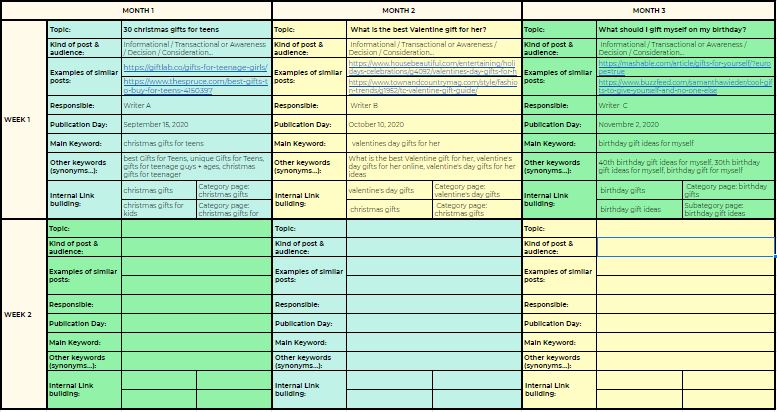Building an SEO content calendar involves planning content clusters around pillar topics and organizing an editorial strategy that aligns with SEO goals, audience needs, and publishing schedules. This approach ensures consistent, targeted content production that improves search visibility and user engagement.
Key steps to build an SEO content calendar with content clusters and editorial strategy include:
-
Define SEO Goals and Audience
Clarify your SEO objectives (e.g., increase organic traffic, improve rankings) and identify your target audience’s preferences and search behavior to tailor content effectively. -
Conduct Keyword Research
Use SEO tools like Google Keyword Planner, SEMrush, or Ahrefs to find primary and secondary keywords for your pillar topics and cluster content. This research guides content relevance and optimization. -
Plan Content Clusters
Organize your calendar around pillar pages (broad, authoritative content) and supporting cluster content (related, detailed articles). Schedule pillar pages first, then fill in clusters to build topical authority and internal linking structures. -
Create a Content Calendar Template
Use tools like Google Sheets, Airtable, Trello, or project management apps to build a calendar that includes:- Content title and type (pillar or cluster)
- Target keywords
- Funnel stage (awareness, consideration, decision)
- Publish date and author
- Content status (draft, review, published)
- Internal linking plan
- Call to action (CTA) and promotion channels.
-
Schedule and Organize Content
Plan publishing dates strategically, often scheduling SEO content 1-2 months ahead to allow for optimization and ranking. Alternate cluster topics to maintain variety and cover multiple audience interests. -
Assign Resources and Set Deadlines
Clearly define who is responsible for each piece and set deadlines to ensure smooth workflow and timely publication. -
Leverage SEO and Analytics Tools
Continuously monitor keyword rankings, content performance, and adjust your calendar based on data insights to improve SEO outcomes. -
Integrate Promotion and Distribution
Plan content promotion on social media and other channels, scheduling posts to drive traffic back to your site and maximize reach.
By following these steps, your SEO content calendar becomes a strategic roadmap that aligns content creation with SEO best practices, audience needs, and business goals, ensuring consistent, high-quality content delivery that supports search engine visibility and user engagement.





